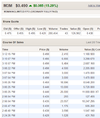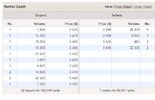- Apr 10, 2017
- 2,165
- 4,074
- AFL Club
- Hawthorn
- Other Teams
- Saints
Thanks for he info on TSI. I havent used it before... Will try and backtest asap.What I've been doing over the past week and a half:
- I pumped and dumped XOM after the share price went absolutely bananas - it always feels good to pump and dump an evil company
- I recalculated how I measured volatility for each stock/ETF because I realised that they current broad based approach - ideally keep investments within a range of 10% either way - wasn't taking into account how bond/currency ETFs were much less volatile than stock ETFs, so I was losing out on opportunities to sell and buy
- To this end, what I did was take an ETF that was close to the mean in terms of portfolio volatility (10%), divided the percentage of my portfolio that said ETF comprised by a figure which approximated 1 standard deviation both ways (15), and then divided the 3-year standard deviation of the ETF by the mean standard deviation of my entire portfolio.
I found said SD by using morningstar.com and clicking on risk (NOT morningstar.com.au), and if that figure wasn't available I either used the index/category SD (depending on how appropriate for the ETF it was) or cross-checked with the 1-year (?) SD available on the www2.asx.com.au website for each ETF. If the 1-year SD was unusually high, as it was for HLTH, I assumed that the 3-year SD was up to 1.5 times higher (more like 1.25 for bond ETFs), which is reasonably consistent with what I've found when examining differences between 1-year and 3-year SD on sites like Fidelity.
I used a 3-year SD because a 1-year SD might be misleading if the market was behaving unusually for some reason, whereas a 5-year SD would exclude many newer ETFs and maybe not fully consider recent fluctuations.
After doing that, I realised that GGOV, AGVT and HLTH were too volatile for my liking (HLTH in particular was dangerously volatile, nearing a 3-year SD of 20%), and so I cut my losses in all three.
With stocks, what I did was use Refinitiv (available via SelfWealth Premium) to figure out the 5-year SD, divide that by the 5-year SD for VOO (S&P 500) or STW (S&P ASX 200) and then multiplied that by the 3-year equivalents for both.
- I then split my sector analysis into three categories: the ones I expected to do consistently well going forward in 2022 (blue), the ones I expected to do well at various periods in 2022 (green), and the ones I expected to plummet (red). I split some sectors - healthcare/communication staples into two because growth-oriented and blue-chip healthcare are quite different animals. The former would do reasonably well during disinflationary downturns, but not so much during stagflation, whereas the latter would hold its own in both scenarios.
- I replaced the Trend Trigger Factor with the True Strength Index - the latter is not as volatile and hence more indicative of how bullish/bearish a stock/ETF really is. I also got rid of the Linear Regression Std Dev and Donchian Price Channels because they needlessly overcomplicated my analysis, and I reinterpreted the Linear Regression 100% figure and the DMI while modifying my use of the Std Dev measurement to make sure it would be at the midway point between the Linear Regression 50% and 100% figures.
I reckon that the Trend Trigger Factor would be more suitable in less volatile markets, but I think that using both that and the TSI at once would just complicate things too much, and I have a bad habit of doing that. So I'll just switch back to the TTF when the market is less volatile. Kanga Commando The Cryptkeeper jd2010 might be interested in re-reading that old post of mine, because I made my edits there.
FWIW - Although I normally test trend trading indicators, lately i have come across several support/resistance as well as trend reversal indicators. They generally require more screen time as they are basically for scalping on FX and indices. Let me know if thats of interest and i will post some details.






